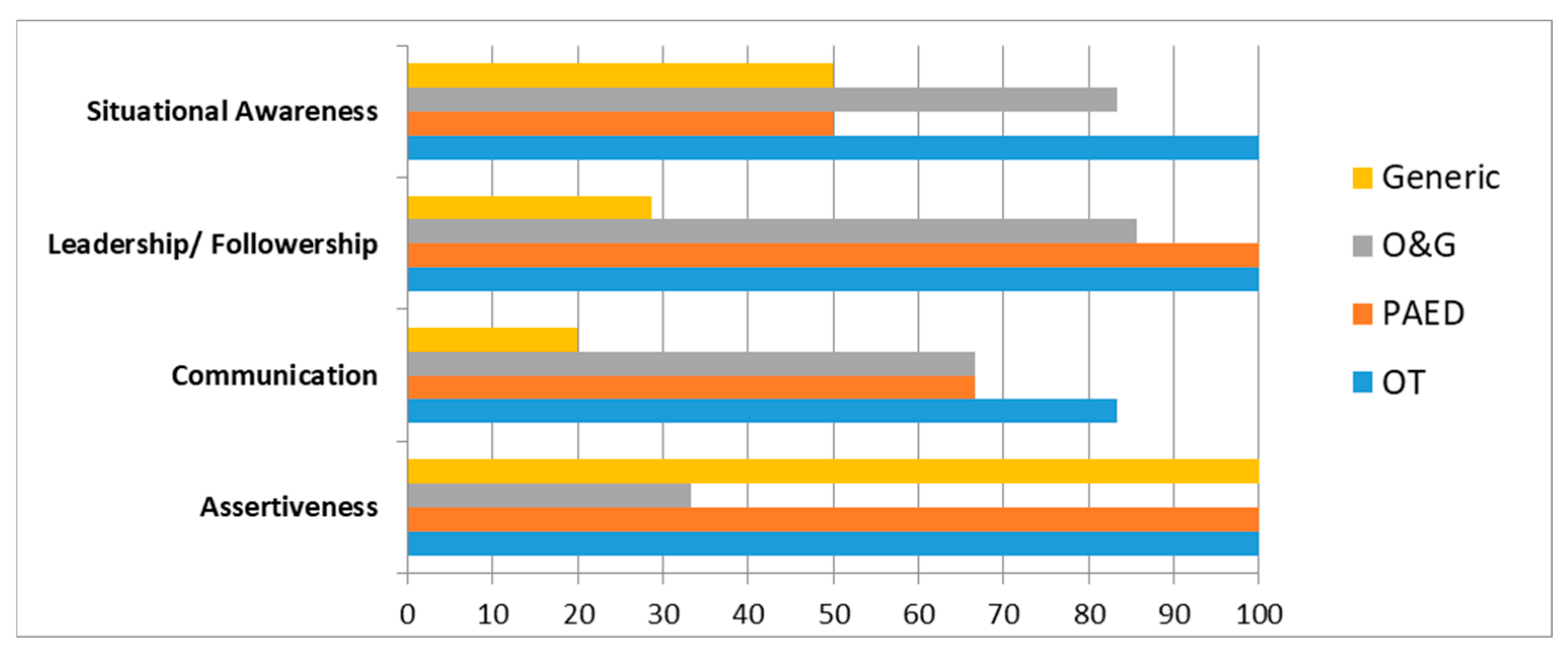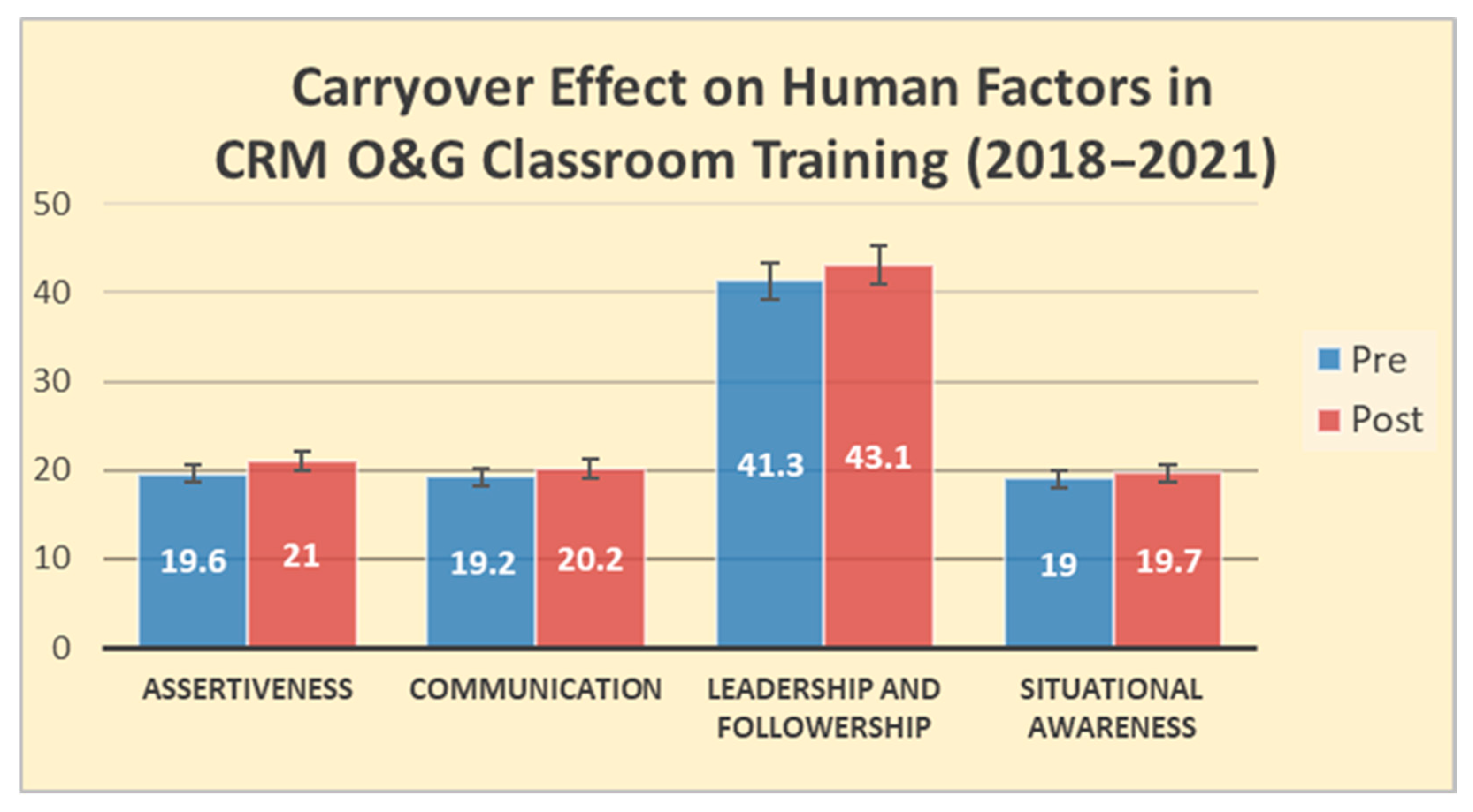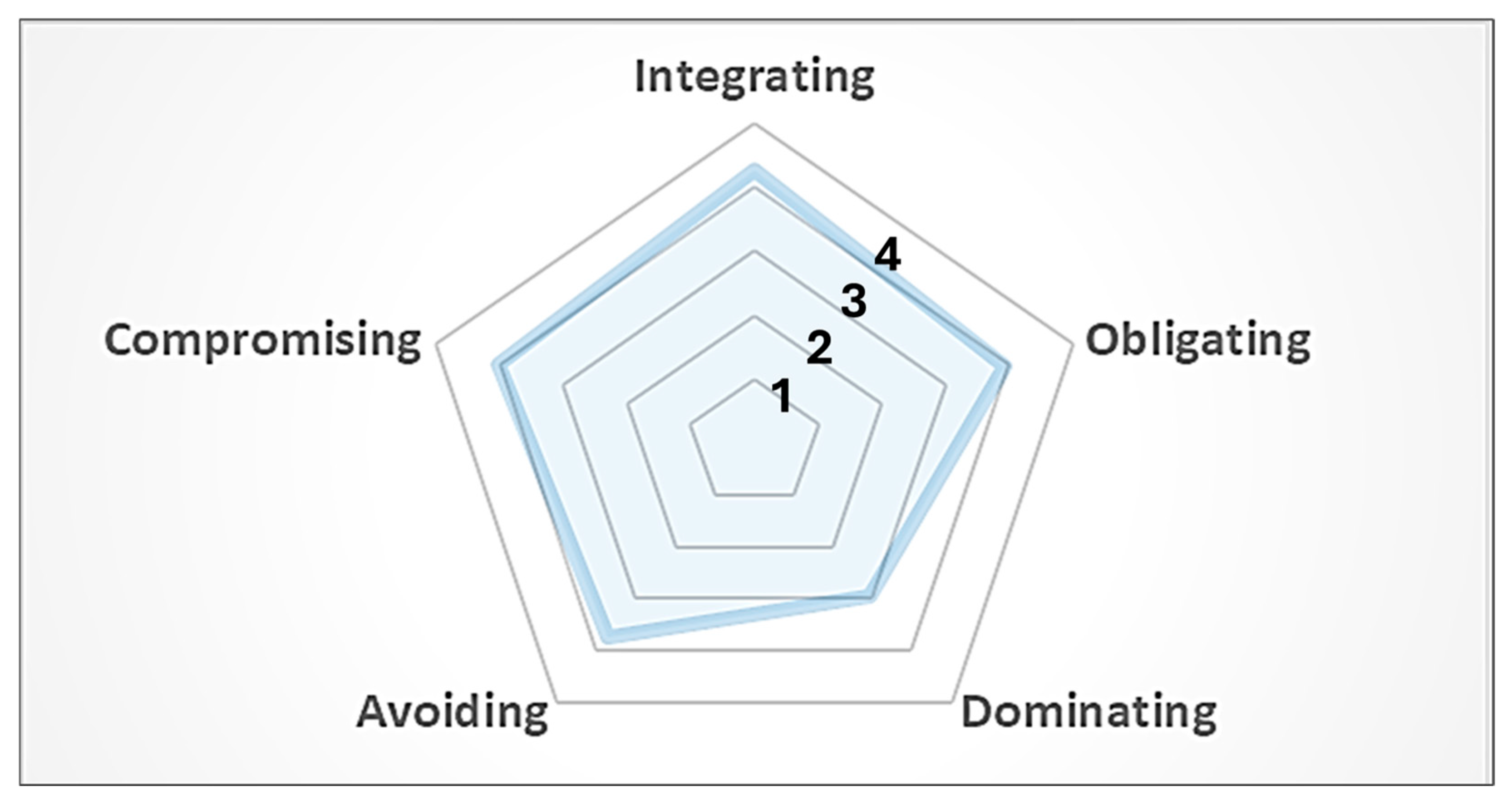Transformation of Teamwork and Leadership into Obstetric Safety Culture with Crew Resource Management Programme in a Decade
Abstract
1. Introduction
2. Phase I: Transformative Changes in Attitudes Towards Human Factors (2016–2018)
2.1. Objectives
2.2. Methods
2.2.1. Procedures
2.2.2. Participants
2.2.3. Measures and Instruments
2.2.4. Data Analysis
2.3. Results and Interpretation
3. Phase II: O&G Specialty-Based Training and Behavioural Shifts (2018–2021)
3.1. Objectives
3.2. Methods
3.2.1. Procedures
3.2.2. Participants
3.2.3. Measures and Instruments
3.2.4. Data Analysis
3.3. Results and Interpretation
4. Phase III: Integration of Conflict Management into CRM Training (2021–2024)
4.1. Objectives
4.2. Methods
4.2.1. Procedures
4.2.2. Participants
4.2.3. Measures and Instruments
4.2.4. Data Analysis
4.3. Results and Interpretation
5. Way Forward: Impact on Clinical Safety and Team Dynamics (2025 and Beyond)
6. Conclusions
Author Contributions
Funding
Institutional Review Board Statement
Informed Consent Statement
Data Availability Statement
Acknowledgments
Conflicts of Interest
Abbreviations
| CRM | Crew Resource Management |
| O&G | Obstetrics and Gynaecology |
| IPE | Inter-Professional Education |
| QEH | Queen Elizabeth Hospital |
| ACLS | Assertiveness, Communication, Leadership, and Situational Awareness |
| OT | Operating Theatre |
| HFAS | Human Factor Analysis Survey |
| SEBA-28 | Self-Evaluated Behaviour Assessment |
| ROCI-II | Rahim Organisational Conflict Inventory |
| GSE | General Self-Efficacy |
| SSE | Specific Self-Efficacy |
References
- Hospital Authority. Hospital Authority Quality and Risk Management. Annual Report (2012–2013); Hospital Authority: Hong Kong, 2013; Available online: https://www.ha.org.hk/visitor/ha_visitor_index.asp?Content_ID=212441 (accessed on 1 August 2025).
- Chan, C.K.; So, E.H.; Ng, G.W.; Ma, T.W.; Chan, K.K.; Ho, L. Participant Evaluation of Simulation Training Using Crew Resource Management in a Hospital Setting in Hong Kong. Hong Kong Med. J. 2016, 22, 131–137. [Google Scholar] [CrossRef] [PubMed]
- Cook, D.A.; Hatala, R.; Brydges, R.; Zendejas, B.; Szostek, J.H.; Wang, A.T.; Erwin, P.J.; Hamstra, S.J. Technology-enhanced simulation for health professions education: A systematic review and meta-analysis. JAMA 2011, 306, 978–988. [Google Scholar] [CrossRef]
- Manojlovich, M.; Antonakos, C.L.; Ronis, D.L. Intensive care units, communication between nurses and physicians, and patients’ outcomes. Am. J. Crit. Care 2009, 18, 21–30. [Google Scholar] [CrossRef] [PubMed]
- So, E.H.; Cheung, V.K.; Chan, L.; Yip, J.W.; Wong, P.; Cheung, S.H.; Chia, N.; Ng, G.W. Strengthening service integration of non–locally trained healthcare professionals through crew resource management: Longitudinal measures and beyond. Hong Kong Med. J. 2025, 31, 331–332. [Google Scholar] [CrossRef] [PubMed]
- Rahim, M.A.; Magner, N.R. Confirmatory factor analysis of the styles of handling interpersonal conflict: First-order factor model and its invariance across groups. J. Appl. Psychol. 1995, 80, 122–132. [Google Scholar] [CrossRef] [PubMed]
- Rahim, M.A. A measure of styles of handling interpersonal conflict. Acad. Manag. J. 2019, 26, 368–376. [Google Scholar] [CrossRef]
- Schwarzer, R.; Jerusalem, M. Generalized Self-Efficacy scale. In Measures in Health Psychology: A User’s Portfolio. Causal and Control Beliefs; Weinman, I.J., Wright, S., Johnston, M., Eds.; NFER-NELSON: Windsor, UK, 1995; pp. 35–37. [Google Scholar]
- Schwarzer, R.; Renner, B. Health-Specific Self-Efficacy Scales. Freie Universität Berlin. 2009. Available online: https://userpage.fu-berlin.de/health/healself.pdf (accessed on 2 January 2018).
- Zhang, J.X.; Schwarzer, R. Measuring optimistic self-beliefs: A Chinese adaptation of the General Self-Efficacy (GSE) scale. Psychologia 1995, 38, 174–181. [Google Scholar]



| Categories | Assertiveness (3 Items) | Communication (6 Items) | Leadership/ Followership (7 Items) | Situational Awareness (6 Items) | Overall (22 Items) | |
|---|---|---|---|---|---|---|
| All (n = 168) | 100% | 100% | 100% | 100% | 100% | |
| By Specialty of CRM Class | OT (n = 42) | 100% | 83.3% | 100% | 100% | 95.5% |
| PAED (n = 63) | 100% | 66.7% | 100% | 50% | 77.3% | |
| O&G (n = 31) | 33.3% | 66.7% | 85.7% | 83.3% | 72.7% | |
| Generic (n = 32) | 100% | 50% | 28.6% | 50% | 50% | |
| By Type of Professional | Doctor (n = 30) | 100% | 33.3% | 57.1% | 50% | 54.5% |
| Nurse (n = 138) | 100% | 100% | 100% | 100% | 100% | |
| Self-Evaluated Behaviour Assessment (SEBA-28) | 2018/19 | 2019/20 | 2020/21 | Total | ||||
|---|---|---|---|---|---|---|---|---|
| Pre Test M ± SD | Post Test M ± SD | Pre Test M ± SD | Post Test M ± SD | Pre Test M ± SD | Post Test M ± SD | Pre Test M ± SD | Post Test M ± SD | |
| Total Score (r= 0.953) | 102.8±11.0 | * 110.3±8.2 | 103.9 ± 7 | 105.1 ± 9.4 | 96.5 ± 11.3 | * 105.1 ± 6.2 | 99.2 ± 9.9 | ** 103.9 ± 8.2 |
| Assertiveness (r= 0.859) | 19.1 ± 1.9 | * 20.6 ± 1.5 | 20.5 ± 1.9 | * 21.2 ± 1.7 | 18.9 ± 2.1 | ** 21.1 ± 2.0 | 19.6 ± 2.1 | ** 21.0 ± 1.7 |
| Communication (r= 0.874) | 18.3 ± 2.2 | * 20.0 ± 1.6 | 20.3 ± 1.9 | 20.3 ± 2.1 | 18.7 ± 2.1 | * 20.3 ± 1.2 | 19.2 ± 2.3 | ** 20.2 ± 1.7 |
| Leadership and Followership (r= 0.905) | 39.9 ± 4.4 | * 42.3 ± 3.9 | 43.2 ± 3.7 | 43.7 ± 4.8 | 40.0 ± 6.0 | * 43.8 ± 3.7 | 41.3 ± 4.6 | ** 43.1 ± 4.3 |
| Situational Awareness (r= 0.888) | 18.2 ± 2.7 | * 19.3 ± 2.0 | 19.9 ± 2.1 | 19.9 ± 2.3 | 18.9 ± 2.1 | 19.8 ± 1.0 | 19.0 ± 2.4 | * 19.7 ± 2.0 |
| n = 95 | 2021/22 | 2022/23 | 2023/24 | 2021–2024 | |||||
|---|---|---|---|---|---|---|---|---|---|
| ROCI-II | Highest Score | Pre Test M ± SD | Post Test M ± SD | Pre Test M ± SD | Post Test M ± SD | Pre Test M ± SD | Post Test M ± SD | Pre Test M ± SD | Post Test M ± SD |
| Integrating | 5 | 4.31 ± 0.47 | 4.30 ± 0.57 | 4.27 ± 0.55 | 4.37 ± 0.55 | 4.16 ± 0.59 | 4.22 ± 0.60 | 4.25 ± 0.54 | 4.31 ± 0.57 |
| Obliging | 5 | 4.06 ± 0.60 | 3.96 ± 0.59 | 3.98 ± 0.57 | 3.99 ± 0.62 | 3.77 ± 0.67 | 3.83 ± 0.61 | 3.93 ± 0.61 | 3.93 ± 0.60 |
| Dominating | 5 | 2.91 ± 0.71 | 2.65 ± 0.63 | 2.79 ± 0.61 | 3.07 ± 0.62 | 3.07 ± 0.68 | 3.02 ± 0.60 | 2.91 ± 0.66 | 2.95 ± 0.63 |
| Avoiding | 5 | 3.77 ± 0.54 | 3.62 ± 0.62 | 3.90 ± 0.54 | 3.86 ± 0.61 | 3.57 ± 0.60 | 3.56 ± 0.59 | 3.76 ± 0.57 | 3.71 ± 0.61 |
| Compromising | 5 | 3.96 ± 0.60 | 3.86 ± 0.69 | 4.11 ± 0.57 | 4.10 ± 0.52 | 3.97 ± 0.59 | 3.97 ± 0.57 | 4.03 ± 0.58 | 4.00 ± 0.59 |
| GSE | 40 | 27.61 ± 0.45 | 28.57 ± 3.92 | 26.74 ± 4.07 | 27.33 ± 4.52 | 28.50 ± 3.79 | 27.33 ± 6.38 | 27.51 ± 4.12 | 27.63 ± 5.04 |
| SSE | 32 | 24.04 ± 0.28 | 24.13 ± 3.51 | 21.79 ± 4.27 | 21.98 ± 4.19 | 22.43 ± 3.23 | 21.93 ± 5.19 | 22.54 ± 3.88 | 22.48 ± 4.44 |
Disclaimer/Publisher’s Note: The statements, opinions and data contained in all publications are solely those of the individual author(s) and contributor(s) and not of MDPI and/or the editor(s). MDPI and/or the editor(s) disclaim responsibility for any injury to people or property resulting from any ideas, methods, instructions or products referred to in the content. |
© 2025 by the authors. Licensee MDPI, Basel, Switzerland. This article is an open access article distributed under the terms and conditions of the Creative Commons Attribution (CC BY) license (https://creativecommons.org/licenses/by/4.0/).
Share and Cite
So, E.H.-K.; Cheung, V.K.-L.; Ng, C.-W.; Chan, C.-N.; Wong, S.-W.; Wong, S.-K.; Lau, M.K.-W.; Ma, T.W.-L. Transformation of Teamwork and Leadership into Obstetric Safety Culture with Crew Resource Management Programme in a Decade. Healthcare 2025, 13, 2564. https://doi.org/10.3390/healthcare13202564
So EH-K, Cheung VK-L, Ng C-W, Chan C-N, Wong S-W, Wong S-K, Lau MK-W, Ma TW-L. Transformation of Teamwork and Leadership into Obstetric Safety Culture with Crew Resource Management Programme in a Decade. Healthcare. 2025; 13(20):2564. https://doi.org/10.3390/healthcare13202564
Chicago/Turabian StyleSo, Eric Hang-Kwong, Victor Kai-Lam Cheung, Ching-Wah Ng, Chao-Ngan Chan, Shuk-Wah Wong, Sze-Ki Wong, Martin Ka-Wing Lau, and Teresa Wei-Ling Ma. 2025. "Transformation of Teamwork and Leadership into Obstetric Safety Culture with Crew Resource Management Programme in a Decade" Healthcare 13, no. 20: 2564. https://doi.org/10.3390/healthcare13202564
APA StyleSo, E. H.-K., Cheung, V. K.-L., Ng, C.-W., Chan, C.-N., Wong, S.-W., Wong, S.-K., Lau, M. K.-W., & Ma, T. W.-L. (2025). Transformation of Teamwork and Leadership into Obstetric Safety Culture with Crew Resource Management Programme in a Decade. Healthcare, 13(20), 2564. https://doi.org/10.3390/healthcare13202564






